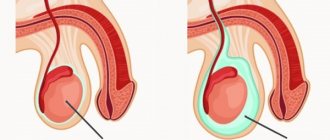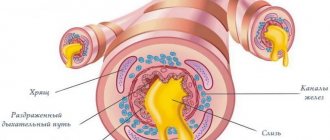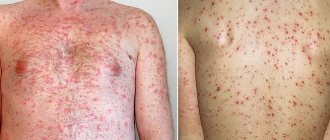Perianal dermatitis is a disease that occurs in people of all ages, from infants to the elderly. This disease is extremely unpleasant and causes a lot of inconvenience, and therefore requires prompt medical intervention. The causes of such dermatitis are varied and for treatment it is necessary to first identify them.
In this article we will look at how and why the disease manifests itself, symptoms and treatment methods, both medicinal and traditional. We will find out what complications can arise and how to avoid them by taking preventive measures to prevent the disease.
What it is?
If the appearance of perianal dermatitis in children is usually associated with a violation of child hygiene standards, then an “adult” disease usually occurs against the background of pathologies of the large intestine and rectum. These could be diseases of the anal area, a violation of the intestinal microflora, an allergic reaction of the body, etc.
Based on the causes of occurrence and characteristic signs, a classification of types of perianal dermatitis has been compiled:
- Allergic form - accompanied by redness of the skin around the anus, a rash of translucent pimples filled with liquid. Often, the manifestation of the allergic form disappears after limiting or completely stopping contact with the allergen.
- The bacterial form is caused by severe itching and pain, coupled with rashes of translucent sores filled with dull green pus. The rashes strongly resemble the herpes virus, since after the integrity of the sores is damaged, dark, crusty ulcers form in their place.
- Fungal form - has clear boundaries of the source of inflammation. This form is characterized by hyperemia (oversaturation of a particular organ with blood) and peeling of the skin. After a while, the redness becomes covered with a whitish film and rash.
- “ Jeep disease ” is the extreme, most severe form of the disease, which is also characterized by purulent rashes. However, over time, acne does not go away, but turns into deep ulcers that cause severe pain. “Jeep disease” is also characterized by a high incidence of complications in the absence of timely treatment.
Any form of perianal dermatitis causes suffering to the patient.
In order to recognize perianal dermatitis, you need to know the symptoms characteristic of this disease:
- Itching and burning in the anal area. When scratching the inflammation, patients usually complain of severe pain.
- As a result of irritation, the skin becomes swollen and red.
- Rashes appear around the anus. Their nature and severity depend on the form of the disease. Over time, the infected areas of the skin become covered with a crust.
Of course, making an accurate diagnosis is the job of a doctor, but based on the listed symptoms, you can navigate the behavior pattern when getting rid of the disease.
Diagnostics
The manifestation of oral dermatitis on the face can be confused with the symptoms of atopic dermatitis, rosacea and other skin diseases. Therefore, in addition to an external examination, a number of tests are required:
- Blood tests (general and biochemical) do not reveal any significant changes. In some patients, the only deviation is an increase (moderate) ESR, but this, as a rule, is associated not with a skin disease, but with the presence of a focus of chronic infection;
- when conducting special tests to identify a predisposition to allergies, increased sensitivity to staphylococcal and streptococcal antigens is noted;
- Some of the subjects have a hormonal imbalance;
- the amount of pathogenic microflora when taking samples from the affected area appears to be increased.
Photo
In the photo below you can see the external manifestations of the disease:
Reasons for appearance
Almost any disease occurs due to a number of unfavorable factors affecting the body. The causes of perianal dermatitis include :
- Infectious intestinal diseases accompanied by prolonged diarrhea.
- Passive lifestyle.
- Excess weight.
- Excessive passion for cycling.
- Inappropriate underwear (synthetic, too tight).
- Violation of the rules of hygienic care of the skin around the anus.
- Anal fissures.
- Haemorrhoids.
- The presence of diseases that have a parasitic basis.
- Chronic bowel diseases.
- Mechanical damage to the skin.
- Weakening of the immune system.
- Poor quality washing of underwear, etc.
The reasons for the development of the disease are varied. Some arise due to the fault of the patient, others do not depend on him. Attentive attitude to your body and timely intervention can help you get rid of the disease.
Experts identify risk groups that are most often susceptible to developing the disease. So, the following stand out separately:
- representatives of non-traditional sexual orientation;
- HIV-infected;
- elderly;
- people who neglect personal hygiene.
People who take certain medications (for example, antibacterials) for a long time are susceptible to the development of perianal dermatitis.
other methods
A good addition to the treatment of perianal type dermatitis are special procedures performed in medical institutions. Some clinics offer patients a service such as medicinal baths. This procedure is paid, but in terms of efficiency it occupies one of the leading places.
There are other physiotherapy treatments against perianal type dermatitis:
- treatment of diseases with ultrasound;
- elimination of disease with laser;
- magnetotherapy.
How to treat?
Treatment of perianal dermatitis, like any other disease, is to eliminate the root cause of inflammation and its negative consequences. First of all, it is necessary to pay increased attention to measures to improve personal hygiene . Next, you should reconsider your preferences in choosing underwear, leaning toward cotton and excluding synthetic ones.
In cases where dermatitis is a consequence of another disease, it is important to take measures to treat the disease that caused inflammation of the anus.
In the fight against the disease, patients, as a rule, resort to the use of medications, but do not refuse the help of effective methods of traditional medicine that complement traditional medicine.
Drug treatment
Before starting to treat a particular disease, the doctor needs to conduct a diagnosis, take tests and determine the source of the problem. For perianal dermatitis, a specialist will visually assess the affected area and prescribe treatment after receiving test results:
- feces;
- X-ray;
- Ultrasound;
- colonoscopy;
- coprogram;
- rectogram.
Treatment cannot be limited to taking medications alone, as it will not be effective enough. The patient will need to reconsider his lifestyle and adjust his diet .
The diet for dermatitis should include more vegetables and dairy products, and limit the intake of heavy meals that cause gas formation and diarrhea. In addition to proper nutrition, it is recommended to go in for sports, but not to abuse excessive physical activity.
When prescribing medications, you should pay special attention to the age of the patients, since some medications are contraindicated for young children or the elderly.
Drug treatment, depending on the reasons that provoked inflammation of the anal area, includes taking several groups of drugs:
- Antihistamines - prescribed for allergic reactions of the body (for example, Claritin or Zodak).
- Ointments for external application with antifungal and antibacterial properties (Triderm, Candide are often used in treatment).
- Anthelmintic drugs are prescribed for parasitic diseases (Pyrantel, Vermox).
- Preparations for healing and regeneration of affected areas, effective due to the high content of zinc in their composition (Dexpanthenol).
- Drugs that normalize intestinal microflora.
To speed up healing, physiotherapy is often used as additional measures:
- magnetic therapy;
- laser;
- ultrasound;
- soothing healing baths.
However, in case of rectal bleeding, physiotherapy is contraindicated.
Often, in order to quickly achieve treatment results, purulent rashes are opened and treated with special solutions.
Folk remedies
Treatment of this delicate disease with folk remedies has proven itself well and has gained wide popularity among patients. If it is not possible to visit a doctor, you can alleviate the condition with the help of medicinal herbs.
Effective folk remedies:
Bee propolis is a natural antiseptic. Propolis must be grated or finely chopped and mixed with sunflower oil in equal parts. The resulting mixture must be heated until smooth (you can use the oven). The resulting medicine can be applied to the affected areas of the anal area several times a day using a cotton swab. It has a disinfecting effect and helps in relieving inflammation.
Natural pumpkin juice - relieves inflammation. Cotton swabs soaked in juice are applied to problem areas. Pumpkin pulp is also suitable for treatment. It relieves itching and swelling, helps stop the inflammatory process.
Rosehip or sea buckthorn oil is a bactericidal agent that is also suitable as a lotion.
The recipe is quite simple - plant essential oil is mixed in equal proportions with olive oil.Healing decoctions - suitable for sitz baths. Oak bark, chamomile, string, St. John's wort, aspen bark, black tea, etc. are plants suitable for medicinal purposes. Baths can be done once a day, before bedtime.
Before starting treatment with traditional medicine, it is better to consult a doctor about the advisability of this measure. In severe, advanced cases, medical intervention cannot be avoided.
Possible complications
In the absence of timely treatment, the disease can be neglected until unpleasant and dangerous complications arise, which in turn cause significant harm to overall health. The consequences of perianal dermatitis are :
- Pain between the buttocks.
- Swelling of the anus.
- General malaise.
- Formation of large festered areas, purulent boils.
- Rectal bleeding, dizziness due to significant blood loss.
- Thrombosis.
- Cancer, etc.
In order not to lead the disease to complications, you need to be attentive to your health and promptly consult a doctor without hesitation or delaying the examination.
First symptoms and signs
The first sign by which one can judge the appearance of perioral dermatitis is slight redness of the face . It becomes more pronounced when eating spicy and hot foods. After some time, it acquires a brighter shade, and the skin becomes covered with small pustules 0.4-2.5 mm, similar to acne. Over time, they turn into crusts and peel off. During the course of the disease, the color of the rash changes from red-brown to light brown.
The localization of the rash is more or less symmetrical on the chin, nasolabial folds, nearby areas of the lips, cheeks, and does not merge together. Single rashes may be observed on the temples and bridge of the nose. Diffuse inflammation of the entire face occurs. A specific feature of the disease is a whitish stripe between the labial border and the area of inflammation.
If therapy is not carried out correctly, the process of thickening and roughening of the skin occurs. At the site of the rash, bumpy formations appear that change color over time. A person feels a burning sensation, itching of the skin, and tightness. The disease progresses in waves - stages of exacerbation are replaced by remissions.
To determine that a person has the oral form of dermatitis, you need to consult a dermatologist. To identify the causative agent of the disease, a scraping from the affected area is examined for bacteriological flora.
Prevention
To prevent illness, you can take preventive measures to protect against illness:
- Wear comfortable underwear.
- Maintain personal hygiene standards.
- Treat gastrointestinal diseases in a timely manner.
- Lead a healthy lifestyle: exercise, eat right.
- Strengthen immunity.
- If you have allergies, avoid contact with allergens.
Despite the fact that perianal dermatitis is a fairly common disease, it is quite possible to avoid it.
Any disease is easier to treat at an early stage . Inflammation of the anal area is a delicate ailment in which patients put off visiting a doctor, hoping for a miraculous self-healing. This tactic is a sure way to complications and serious damage to health.
Knowing the causes of the disease, you can avoid it by taking a number of preventive measures, and in case of illness, begin timely treatment with the help of folk and traditional medicine.
Eczema near the anus
Eczema is considered a common dermatological disease and, according to many doctors, is of an allergic nature, although many specialists find it difficult to accurately determine the causes of the development of such a disease. In particular, there are suggestions that the disease may develop against the background of disruptions in the nervous system and due to increased sweating. Damage to the perianal area can be:
- Spicy. In this case, the disease progresses very quickly, accompanied by redness of the skin, wetness of the skin folds and severe itching. Scratch marks appear on the skin, and the perianal folds become hypertrophied. Over time, erosions, crusts and weeping may occur. Patients often complain of a deterioration in their general condition and the appearance of signs of intoxication.
- Chronic. In this situation, the disease progresses gradually, the skin becomes dry and thin. The main signs of chronic eczema are constant irritation and obsessive itching. Areas of skin depigmentation may appear.












